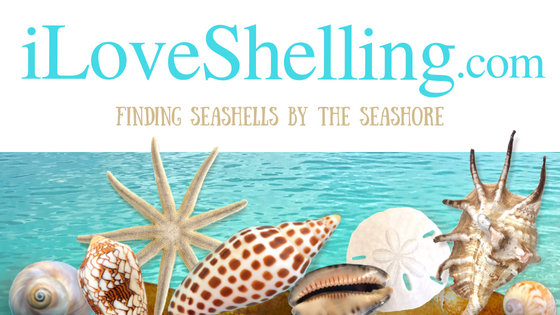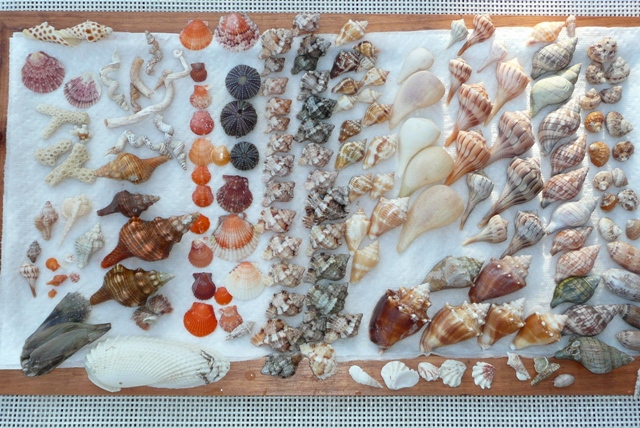It’s a smorgasbord of shells that Ellen ended up finding this weekend! From A to Z….APPLE MUREXES to ZZZ…..oh well, to WORM SHELLS then. Most of these are easy to identify but I’m having just a little trouble on the far left, midway down, second shell in. You think it’s a ROSE MUREX? The tail looks pretty long and I can’t make out if it has spikes or not. I found a ROSE MUREX at Blind Pass last summer so I know that they’re there but maybe a CABRIT’S MUREX? MurexKen, are you out there? And there’s her “vintage” JUNONIA that Deb remarked on yesterday. heehee. Nicely done, Ellen. Thanks for sending your picture.


Pam, I have been enjoying your blog. Concerning the pictured shell, your question is a good one. The overall shape of the shell is that of a Haustellum (aka specific genus of Murex). In the Gulf of Mexico there are two, somewhat “common” Haustellum species, H. rubidium (aka Rose Murex), http://www.gastropods.com/7/Shell_2897.shtml and H. cabritii (aka Cabrit’s Murex), http://www.gastropods.com/3/Shell_1023.shtml Yes, there probably are one or two additional, very rare, deep water Haustellum species, but for the sake of this discussion there really are only two species to consider. So, your initial impression is accurate. The shell is either a Rose Murex or a Cabrit’s Murex. The Rose Murex is usually smaller (1.0 to 1.8 inches in length) and less spinose, often has some nice coloring and has a slightly retroflexed siphonal canal (aka tail). Cabrit’s Murex is usually larger (1.5 to 3 inches) and is much more spinose (on body and siphonal canal), does not have much coloring and has a relatively straight siphonal canal.
On Sanibel Island I have personally found the Rose Murex, but have never found a Cabrit’s Murex. As you probably know, The Rose Murex can be found in fairly shallow water, where as Cabrit’s Murex is rarely present in less than 60-70 feet of water. I have found it scuba diving and dredging, but never on the beach. To get to a Sanibel Island beach, a Cabrit’s Murex would have to travel many miles, much farther than would a Rose Murex. The Sanibel Shell Museum lists the Rose Murex, http://shellmuseum.org/shells/shelldetails.cfm?id=75 but does not list the Cabrit’s Murex as one of the shells able to be found on Sanibel Island. Since I have found other shells on Sanibel Island that are not listed on the Shell Museum’s list, I suspect that Cabrit’s Murex is another one that Dr. José Leal will soon add to his on-line list. So, Cabrit’s Murex is still a possibility, although less likely than the Rose Murex.
With this background information, I will comment on the specific shell in the picture. As a light colored shell on a white background, the fine details of the shell are more difficult to see. Unfortunately, there are no close up pictures of the shell (front, back and side). Although an accurate size determination is difficult, I estimate its length to be between 1.5 and 2 inches, based primarily on the size of the other shells in the picture. Since it is a beach worn specimen, any spines that may have been originally present have now been broken off. The shell does not appear to have much coloring, and the siphonal canal appears to be fairly straight, at least in two dimensions. In summary, these features seem to favor the pictured shell being a Cabrit’s Murex, despite it being a much less common shell on Sanibel Island. If the siphonal canal does have a number of spines, then the shell is definitely a Cabrit’s Murex. So, I guess this is just a long way of saying that I basically agree with you.
Maybe Ellen could take her Murex to the Shell Museum and have someone there look at it. Wednesday mornings at the Shell Museum there usually are a number of volunteers who would be happy to look at her shell. If Dr. Leal thinks the shell is a Rose Murex, I will defer to his expert opinion and claim that there is only so much one can do with a picture. ;~) If Dr. Leal thinks it is a Cabrit’s Murex, I’m sure that he would like to see it and maybe would even like to photograph it. Then Ellen could have her name in the on-line list of shells.
Hope this is helpful, MK
Wow, MurexKen, thank you so much for this information and for including the links! I’ve emailed Ellen to make sure she takes a close up photo and to get to the shell museum. I’m keeping my fingers crossed for her that it’s the Cabrit’s. We are so fortunate to have the Bailey-Matthews Shell Museum right at our fingertips.